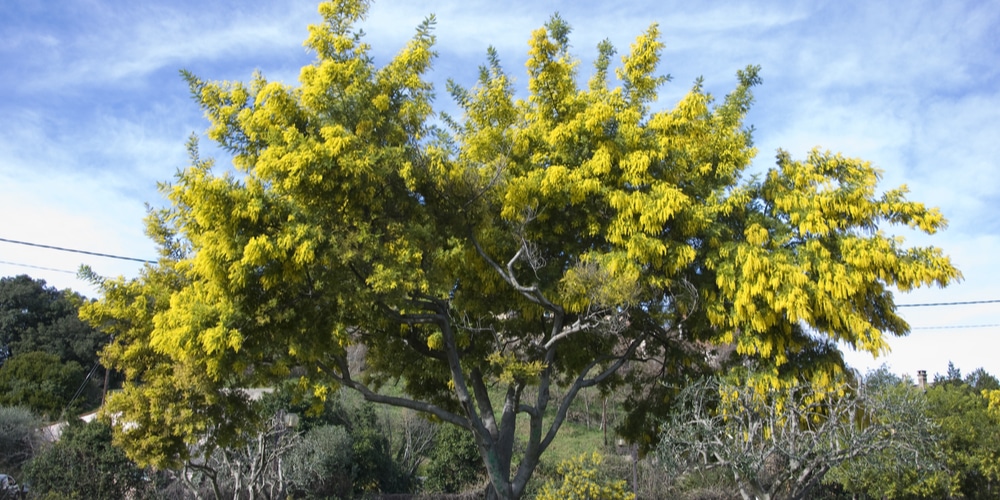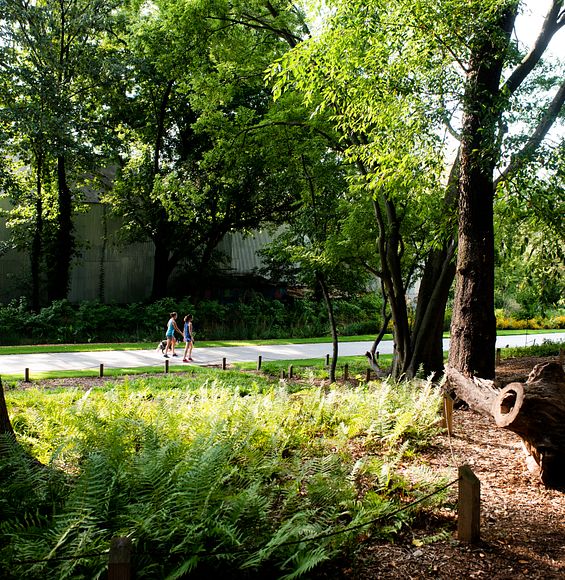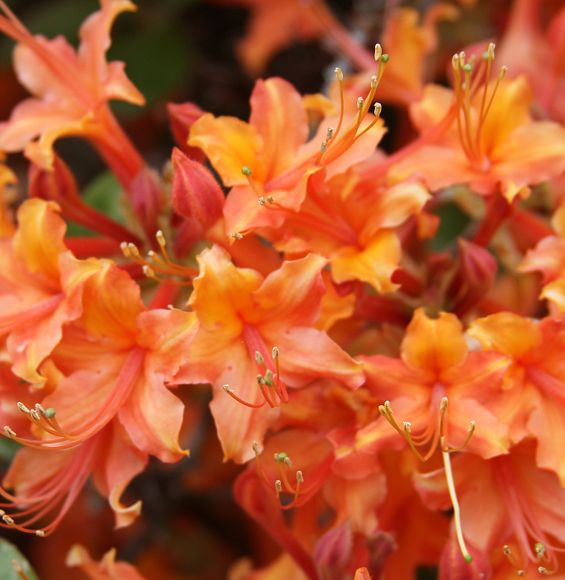These recommendations are primarily for homeowners and communities that would like to start working in their neighborhood greenspace. For each species we recommend herbicide-free control methods, but have added an herbicide option for some species for those who are comfortable using them. These methods were selected while keeping in mind limiting soil disturbance, reducing herbicide use, and avoiding harm to other species that may be present whether they be other plants/animals. Manual removal is possible for all of them if you have the time. If the infestation is overwhelmingly severe or these tips aren’t proving effective, we suggest you consider qualified professional services.
For certain woody invasive plants that have shallow roots, uprooting is an easy method of control. Some woody invasive trees and shrubs have deeper tap roots that make hand pulling difficult. If the trunk has a diameter of less than 1” hand pulling could be a viable option.
If the diameter is between 1-3”, try using an uprooter (a.k.a., “Pullerbear”). These tools will save your back (and are very satisfying to use) and are a great choice for those who are trying to avoid using any herbicides.
Mimosa trees also known as silk trees, are fast-growing trees that can quickly spread and take over large areas. While their pink puffy flowers and fern-like leaves may seem appealing, mimosa trees are actually considered an invasive plant in many parts of the world.
If you have a mimosa tree on your property that you want to get rid of, this comprehensive guide will provide you with useful information and effective methods to kill and remove these unwanted trees
Understanding Mimosa Trees
Mimosa trees (Albizia julibrissin) are deciduous trees that are native to China but have spread to many other parts of Asia, Africa, South America, and North America. They were introduced to the United States in 1745 as an ornamental plant.
Mimosa trees can grow up to 40 feet tall and spread out up to 30 feet wide. They have bipinnately compound leaves that look similar to ferns and fragrant pink flowers that bloom in summer. The flowers produce long, bean-like seed pods that contain numerous seeds.
While they may seem like nice landscape trees at first, mimosa trees are actually considered an invasive plant in over 30 states, including most of the southern United States. Once established, mimosa trees spread aggressively and outcompete native plants and trees.
Why Remove Mimosa Trees?
There are several important reasons to remove mimosa trees from your property:
-
They spread rapidly: Mimosa trees grow and reproduce quickly, producing thousands of seeds that spread easily on the wind. They can quickly take over large areas.
-
They damage infrastructure: The extensive root systems of mimosa trees can damage sidewalks, foundations, septic systems, and underground pipes.
-
They outcompete native plants: Mimosa trees crowd out beneficial native plants that provide food and habitat for wildlife. This negatively impacts ecosystems.
-
They have short lifespans: Mimosa trees are relatively short-lived, only living around 20-30 years. As they age, they become susceptible to disease and damage from storms.
-
They increase wildfire risk: The abundant leaves and seed pods of mimosa trees provide ample fuel for wildfires to spread rapidly.
Getting rid of mimosa trees as soon as possible can help avoid expensive damage and prevent mimosas from spreading further on your property.
Methods to Kill and Remove Mimosa Trees
Killing mimosa trees requires patience and persistence. Young seedlings can be hand pulled, while mature trees will need to be cut down and likely treated with herbicide to prevent regrowth. Here are some recommended methods:
Remove Seedlings
-
Monitor your property frequently for young mimosa seedlings that may sprout from wind-dispersed seeds.
-
Hand pull seedlings as soon as you spot them. Wear gloves and pull slowly to remove as much of the root system as possible.
-
Place pulled seedlings into plastic bags and throw away; do not compost them.
-
Focus on removing seedlings before they are able to flower and produce more seeds.
Cut Down Mature Trees
-
Use a chainsaw or handsaw to cut down large mimosa trees close to the ground.
-
To prevent resprouting, the stump must also be treated with herbicide immediately after cutting.
-
Apply a concentrated glyphosate herbicide with a paintbrush to the freshly cut stump. This will kill the remaining roots.
-
Monitor the stump site for several months and promptly treat any new shoots with more herbicide as they emerge.
-
Once the stump is dead, you can dig it up or grind it down below soil level.
Use Herbicide on Smaller Trees
-
For smaller saplings or resprouts, foliar herbicide sprays can be effective. Spray glyphosate or triclopyr-based products directly on the leaves.
-
Follow product labels closely for correct dilution rates and timing of application. Spray late in the growing season for best results.
-
Be extremely careful that herbicide does not drift onto desired plants or trees nearby. Target mimosas only.
-
Several treatments over the course of a growing season may be required to fully kill smaller trees. Monitor closely.
Remove Root Systems
-
After a mimosa tree is dead, the root system still remains in place underground. This can lead to new sprouts.
-
Carefully dig up as much of the roots as possible, especially larger taproots. Use an ax or saw to cut thicker roots.
-
For large trees, you may need heavy equipment like a backhoe to fully remove the stump and roots. Rent equipment if needed.
-
Removing the entire root system when possible helps prevent mimosas from regrowing in the future.
Follow Up Monitoring and Maintenance
-
Diligently watch areas where mimosas have been removed for new seedlings or sprouts.
-
Routinely walk your property and immediately pull or spray any new growth before it matures.
-
Dispose of any seed pods you find on the ground, as they may contain viable seeds. Composting will not kill the seeds.
-
Be prepared for mimosa removal to be a multi-year process. Persistence is key to successful control of this invasive tree.
Proper timing, regular monitoring, and thorough removal methods are all critical for getting rid of mimosas. Be patient, consistent, and willing to provide follow-up maintenance to prevent mimosas from returning. Over time, you can eliminate these invasive trees from your landscape.
Alternative Trees to Plant
Once mimosa trees have been removed, the open areas can be replanted with non-invasive trees better suited to the local ecosystem. Here are some recommended alternative trees:
-
Maples: Sugar maple, red maple, and other maple species provide great fall color and are suited to a variety of soil conditions.
-
Oaks: Choose from many majestic oaks such as live oak, red oak, white oak, and post oak. Oaks support over 500 species of caterpillars.
-
Elms: American elm, cedar elm, and winged elm are native elm species that are resistant to Dutch elm disease.
-
Cypress: Bald cypress and pond cypress trees thrive in wet soils and standing water. They provide shade and habitat.
-
Birch: Paper birch, river birch, and gray birch are attractive trees that perform well in northern climates.
-
Pines: Longleaf pine, shortleaf pine, and loblolly pine are evergreen pines native to southern forests.
Be sure to select tree species that are appropriate for your specific planting site, climate zone, soil type, and rainfall. Consult with local nurseries, extension services, or landscaping professionals for recommendations on suitable replacement trees for your area.
While mimosa trees may seem like attractive landscape specimens at first, their invasive and aggressive habits make them a nuisance that requires removal. Taking the time to properly kill mimosas and prevent regrowth will pay off in the long run by avoiding damage, avoiding spread, and allowing more desirable plants to thrive. With persistence and an integrated approach using manual, mechanical, and chemical control methods, you can successfully get rid of unwanted mimosa trees from your property. The work will be well worth it when you can replant non-invasive trees that are ecologically beneficial.

Eastside Azalea Collection
Despite the native azalea holding the title of Georgia’s State Wildflower, it is underused in the landscape. The Atlanta BeltLine Arboretum is now home to the largest public native azalea collection in the Atlanta Area with over 300 azaleas on display. The collection highlights over 25 species, cultivars, and varieties, and is home to all 13 azaleas native to the state of Georgia. This collection focuses on named cultivars (varieties that have been selected for depending on color, size, bloom time, etc.) within two series called the Georgia Moon Series and the Sunrise to Sunset Series. The Georgia Moon Series will have fragrant white-blooming Georgia native species, and the Sunrise to Sunset Series will be comprised of Georgia native species in warm orange, reds, and soft yellows blooming from March – July.

The Stumpery Garden is a horticultural oddity, serving as a public place for learning and exploration and demonstrating how trees can be utilized in a beautiful way. Stumpery gardens utilize dead, fallen, and storm-damaged trees as an asset to the garden – providing critical habitat for beetles, frogs, birds, and small mammals such as chipmunks. Whole logs are placed upside down to display their root structure, and logs, branches, and pieces of bark are arranged to form walls and archways. Plants such as ferns, lichen, mosses, soft grasses, and trailing plants are encouraged to grow on and around them.
Take a virtual tour of the Stumpery Garden here.

Please watch this BEFORE consuming Mimosa tree! (Tree of Happiness)
FAQ
How do you get rid of a mimosa tree?
Mimosa may be removed with mechanical tools. Use herbicides to prevent resprouting. Girdling may also work on larger trees, but resprouting can still occur. Specific herbicide recommendations can be found on the University of Florida’s plant directory webpage.
Are mimosa trees deep rooted?
Mimosa trees have deep taproots that reach 3 to 6 feet deep into the soil. This makes them unsuitable for container growing.Jun 13, 2025
What spray kills mimosa?
Glyphosate (click for sources) will kill it but you have to be careful to keep the non-selective chemical off nearby foliage.
How do you remove mimosa plants?
Single plants or small outbreaks of mimosa can be removed by hand pulling or grubbing, ensuring that as many roots as possible are removed. There are a variety of effective herbicides that can also be used to eradicate new or small outbreaks.
Can mimosa trees be removed?
Mimosa trees can be a nuisance, but they can be removed. If you have mimosa trees on your property, you can prevent them from growing by pruning them regularly or by using a herbicide. If you have a mimosa tree that is too large to prune, you can remove it by digging it up or by cutting it down.
How do you cut a mimosa tree?
To dig up a mimosa tree, you will need a shovel and a pickaxe. Dig around the tree, making sure to cut through the roots. Once you have dug up the tree, you can remove it from the ground. To cut down a mimosa tree, you will need a chainsaw or a handsaw. Cut the tree down as close to the ground as possible.
What are the disadvantages of Mimosa Wilt?
Another drawback is mimosa wilt—a disease that is becoming a problem across the county and is responsible for killing many roadside trees. Infected trees will start out with paling, drooping leaves on a single branch. As the disease progresses, leaves will turn yellow and fall off the tree.
Can a mimosa tree damage a house?
Cause damage to your home or other structures. Digging up a mimosa tree can damage your foundation or sidewalks. Pruning a mimosa tree can also damage your roof or windows. Q: How can I prevent mimosa trees from growing in my yard? A: There are a few things you can do to prevent mimosa trees from growing in your yard. These include:
What happens if you dig up a mimosa tree?
It is important to read the label of the herbicide carefully and follow the directions exactly. Cause damage to your home or other structures. Digging up a mimosa tree can damage your foundation or sidewalks. Pruning a mimosa tree can also damage your roof or windows. Q: How can I prevent mimosa trees from growing in my yard?
